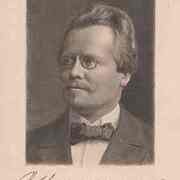Otto Julius Bierbaum (1865–1910)
Autor de Samalio Pardulus
Sobre El Autor
Créditos de la imagen: Photo © ÖNB/Wien
Series
Obras de Otto Julius Bierbaum
Sonderbare Geschichten 3 copias
Der Neubestellte Irrgarten der Liebe: Um Etliche Gaenge und Lauben Vermehrt Verliebte, Launenhafte, Moralische und… (2017) 3 copias
Aus dem Irrgarten der Liebe verliebte, launenhafte, moralische und andere Lieder und Gedichte 3 copias
Gesammelte Werke, sechster Band: Prinz Kuckuck: Leben, Taten, Meinungen und Höllenfahrt eines Wollüstlings (1980) 3 copias
Briefe an Gemma 1 copia
Hans Thoma 1 copia
Ausgewählte Gedichte 1 copia
Zur Kurzweil heitere Geschichten 1 copia
Hamburger Lesehefte : Otto Julius Bierbaum : Zäpfel Kerns Abenteuer : Ein Märchen (1986) — Text — 1 copia
Biographie 1 copia
Das Reimkarussell 1 copia
Gesammelte Werke 1 copia
Zwei Münchener Faschingsspiele 1 copia
Hans Wurst und andere Grotesken 1 copia
Zwei Stilpe-Komödien 1 copia
Das schöne Mädchen von Bao 1 copia
Obras relacionadas
50 seltsame Geschichten — Contribuidor — 1 copia
Velhagen und Klasings Almanach 1909 — Contribuidor — 1 copia
Etiquetado
Conocimiento común
- Otros nombres
- MÖBIUS, Martin
BIERBAUM, Otto Julius - Fecha de nacimiento
- 1865-06-28
- Fecha de fallecimiento
- 1910-02-01
- Género
- male
- Nacionalidad
- Germany
- Lugar de nacimiento
- Grünberg, Schlesien, Deutsches Reich
- Lugar de fallecimiento
- Dresden, Sachsen, Deutschland
- Lugares de residencia
- Dresden, Sachsen, Deutschland
Leipzig, Sachsen, Deutschland
München, Bayern, Deutschland - Ocupaciones
- journalist
editor
writer
librettist
Miembros
Debates
Samalio Pardulus en The Chapel of the Abyss (julio 2021)
Reseñas
También Puede Gustarte
Autores relacionados
Estadísticas
- Obras
- 57
- También por
- 4
- Miembros
- 154
- Popularidad
- #135,795
- Valoración
- 3.9
- Reseñas
- 2
- ISBNs
- 28
- Idiomas
- 2
- Favorito
- 1




Samalio Pardulus was a painter in medieval Albania. Rather than documenting him from an omniscient third-person narrator as in À rebours or through the medium of his own written journals as in Fantazius Mallare, Bierbaum places two narrative frames between the reader and the character. First, there is a "staid philistine" Italian painter Messer Giacomo, imported to instruct Samalio, whose journals form the purported documentary basis of the story in the form of extensive quotations. Then there is the anonymous archivist who introduces and comments on Giacomo's account. Through the course of the book, this archivist outside of the quotes retreats to invisibility, having left behind only a suitable readerly suspicion regarding Giacomo's perceptiveness.
Samalio himself is ugly, talented, and blasphemous. He is concerned with making objects out of his imaginings, and to the extent that this work tends to horrify his pious teacher, his explanations of it become theological, deprecating a cosmic demiurge and exalting his own "godly pleasure in the grotesque" (14). Beyond his inchoate gnosticism and solipsism, Samalio defines himself with incestuous ambitions for his beautiful sister. These eventuate in a numinous domestic apocalypse. The interrelation of the principal characters--Samalio, his sister Maria Bianca, their father the Count, an unnamed watchman, and Messer Giacomo--eventually becomes so outre that it awoke in me suspicions of allegory.
This first English edition is illustrated with many full-page charcoal drawings by Alfred Kubin that appeared in the original 1911 German edition. Some of these depict Samalio's paintings, but most are scenes from the novel.… (más)